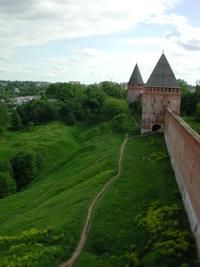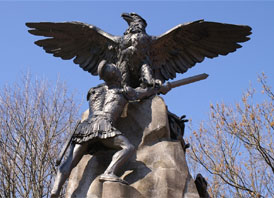
About Smolensk
 Smolensk developed in the upper reaches of the Dnieper as a Slav settlement of the Krivichi tribe. Its history goes back more than 11 centuries. One of the Russian Chronicles mentions Smolensk under the year of 863 in a story about the Varangians led by Askold and Dir who, on their way to Constantinople, reached Smolensk but did not dare to enter it, «for the city was great and rich in people». It is again mentioned in the first Novgorod Chronicle as a city conquered by Prince Oleg in 882. At the end of the 9th century, Smolensk joined the old Russian State «KievenRus», but for a long time it continued to be ruled by the popular assembly - Veche. In the middle of the 10th cen-tury, Smolensk is described as a fortress, in the notes of Constantine Porphyrogenitus, the Byzantine Emperor (946-953). After 1054, the Smolensk princes were the sons of Yaroslav the Wise - Viacheslav and Igor. At the end of the 11th century it became a hereditary seat of Prince Vladimir Monomakh.
Smolensk developed in the upper reaches of the Dnieper as a Slav settlement of the Krivichi tribe. Its history goes back more than 11 centuries. One of the Russian Chronicles mentions Smolensk under the year of 863 in a story about the Varangians led by Askold and Dir who, on their way to Constantinople, reached Smolensk but did not dare to enter it, «for the city was great and rich in people». It is again mentioned in the first Novgorod Chronicle as a city conquered by Prince Oleg in 882. At the end of the 9th century, Smolensk joined the old Russian State «KievenRus», but for a long time it continued to be ruled by the popular assembly - Veche. In the middle of the 10th cen-tury, Smolensk is described as a fortress, in the notes of Constantine Porphyrogenitus, the Byzantine Emperor (946-953). After 1054, the Smolensk princes were the sons of Yaroslav the Wise - Viacheslav and Igor. At the end of the 11th century it became a hereditary seat of Prince Vladimir Monomakh.The principality of Smolensk separated off from KievanRus in the time of Prince RostislavMstislavich, the grandson of Vladimir Monomakh. He ruled the town from 1125 till 1159. In 1134 Rostislav enclosed Smolensk with fortifications. The area of the town had grown considerably as is reflected in the grand scale of monumental building that was extensively developed at the time. Rostislav's sons Roman (ruled Smolensk from 1160 till 1180) and David (1180 - 1197) continued to promote stone building in the town. By the end of the 12th century an independent Smolensk architectural school was established. Big monastery and town cathedrals, princes' palace, parish churches and episcopal churches were built along the banks of the Dnieper mainly on the high points giving the town a most picturesque outline.
 Smolensk was a centre of early medieval Russian culture and learning. The cathedrals and churches in monasteries had scriptoria and monastic schools where Latin and Greek were taught. Smolensk boasted of two outstanding figures in early Russian culture: KlimentSmolyatich, «a philosopher and scholar» who was elected Kievan Metropolitan in 1147, and Reverend Avraamy of Smolensk whose «learning and guidance» were highly appreciated by his contemporaries. Trades and crafts were flourishing. A commercial agreement was concluded in 1229 between Smolensk, Riga and Gotland. In 1239 the Smolensk people defeated Batyi's detachment of horsemen, thus rescuing the town from the Tartar ravages. In 1339 the nomads tried to seize Smolensk again but the town fortifications kept them back.
Smolensk was a centre of early medieval Russian culture and learning. The cathedrals and churches in monasteries had scriptoria and monastic schools where Latin and Greek were taught. Smolensk boasted of two outstanding figures in early Russian culture: KlimentSmolyatich, «a philosopher and scholar» who was elected Kievan Metropolitan in 1147, and Reverend Avraamy of Smolensk whose «learning and guidance» were highly appreciated by his contemporaries. Trades and crafts were flourishing. A commercial agreement was concluded in 1229 between Smolensk, Riga and Gotland. In 1239 the Smolensk people defeated Batyi's detachment of horsemen, thus rescuing the town from the Tartar ravages. In 1339 the nomads tried to seize Smolensk again but the town fortifications kept them back.From the 14th century Lithuania began to put pressure upon Smolensk. In 1404 the Lithuanian prince Vitovt perfidiously seized the town after a two-week struggle. The Smolensk lands were then brought under the Grand Duchy of Lithuania. In 1410 troops from Smolensk joined the Polish and Lithuanian armies in dealing a fatal blow to the Teutonic Knights at the Battle of Griinwald. The courage and determination of the three Smolensk regiments decided the outcome of the battle. In 1440 the Smolensk common folk, united in the Borisoglebsky Brotherhood, rebelled and drove the Lithuanian vice-gerent out of the town. But in 1441 the Lithuanian feudal lords managed to seize Smolensk again. In the time of the Grand Prince of Moscow Vasily III Smolensk was finally liberated and became a part of Muscovy in 1514.
In the middle of the 16th century Tsar Ivan the Terrible gave orders to start the work on a new fortress wall of oakwood. The trans-Dnieper area of the town considerably widened. Two new settlements - Rachevka and Churilovka - appeared on the left bank.IoannKobentsel, who visited the town in 1575, wrote that Smolensk was «as great as Rome». Polish and Lithuanian detachments repeatedly made attempts to win back the town, which was an important strategic point. At the end of the 16th century a decision to fortify the western borders of the state was adopted; and a formidable fortress wall of stone and bricks was built in Smolensk in 1596-1602.
In 1609-1611 the town stood a twenty-month siege by a Polish army under the command of King Sigismund III. «If the Russian state had at least several towns as courageous as Smolensk our enemies would never try to enter our land» - these are the lines from a letter calling for struggle against the interventionists. But in June 1611 Smolensk was forced to surrender. To glorify that heroic defence a majestic new cathedral was erected in 1677-1740.During the Northern War, Smolensk stood in the way of the invaders. Peter I came to the city several times to make sure that it was well fortified to fend off the attacks of the advancing Swedish troops. And when the Russian army defeated the Swedish corps led by General Levengaupt near Lesnaya, a village not far from Smolensk, Peter I welcomed the victorious Russian troops from the Smolensk Town Hall in October 1708. In the same year Smolensk was made one of the administrative centers of the Russian Empire. In 1730 its coat of arms was officially recognized in its present form: a cannon with a bird of paradise sitting on it. In the second half of the 18th century the city was divided into two parts: the citadel and the suburb. New settlements of townsfolk appeared on the outskirts: Dvorianskaya, Ofitserskaya, Soldatskaya. By the end of the 18th century the population of Smolensk had reached 11579 people. The year of 1812 added a glorious page to the history of the city. After Napoleon's invasion, the 1st and 2nd Russian armies, acting initially on their own, united not far from Smolensk where Napoleon's advancing troops met with fierce resistance. The Russian soldiers repulsed the attacks of the French with great courage. During the two days of August 4 and 5, 1812, the French lost about 20 thousand soldiers and officers. The joining of the two Russian armies under the command of Barclay de Tolly and Bagration frustrated Napoleon's plan to rout them one by one and predetermined the outcome of the Battle of Borodino.
At the beginning of the 20th century Smolensk was a small «wooden» provincial town. Only 283 of 2698 buildings were made of stone, among them 40 churches and monasteries. According to the census of the population, 33.9 thousand people lived in Smolensk in 1881. There were just over 30 small enterprises, mainly brickworks, woodworks and breweries, employing one and a half thousand people. Only half of the fifty miles of the streets were paved. In 1894 electricity was installed in Smolensk; the water-supply system worked in the trans- Dnieper district. The tram service was opened on the 7th of October 1901. The extension of the line was about 5 miles. The history of pre-revolutionary Smolensk came to an end on the night of October 31 (November 13), 1917, when the Smolensk Bolsheviks declared the establishment of Soviet power. Now Smolensk was entering the period of economic chaos, then economic restoration, the enthusiasm of the first years of socialist construction, Stalin's monstrous repressions and the Nazi occupation. In June 1941 Smolensk again stood in the path of the enemy, this time the Nazi armies who were advancing towards Moscow. Fierce fighting in the city went on for two weeks. It frustrated the blitzkrieg plan and forced the Nazis to take up defensive tactics for the first time in World War II. On the 25th of September, 1943, Smolensk was finally liberated. The war had caused innumerable sufferings to the people. The town was devastated, it lay in ruins. Less than 13 thousand survived of the 157 thousand inhabitants of pre-war Smolensk. But in spite of the hardships, Smolensk has preserved its unique skyline and character. The ancient churches and the fortress towers,the majestic monuments and small obelisks are the landmarks of its glorious past closely linked with the history of Russia. Smolensk withstood invasions by hostile armies, it was burnt and devastated but it has won the fame of a stronghold of the Russian state. It has become a symbol of staunchness and patriotism.
Booking
- On-line booking
- aW5mb0BzbW9sZW5zay1ob3RlbHMucnUsIHN1cHBvcnRAc21vbGVuc2stdHJhdmVsLnJ1
- NjQ0IDgzNyA5NzI=
- c21vbGVuc2stdHJhdmVs
Was not defined










